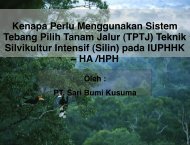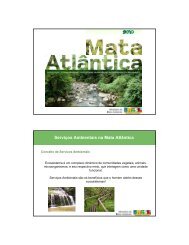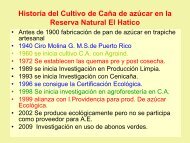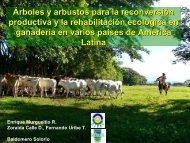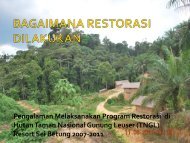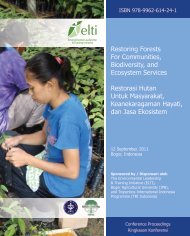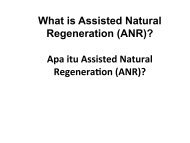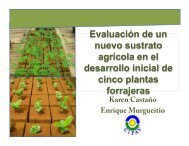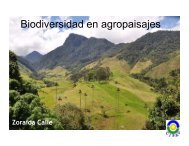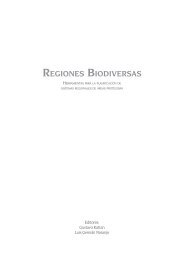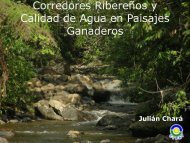lineamientos para demarcar la faja forestal protectora de los ...
lineamientos para demarcar la faja forestal protectora de los ...
lineamientos para demarcar la faja forestal protectora de los ...
Create successful ePaper yourself
Turn your PDF publications into a flip-book with our unique Google optimized e-Paper software.
Enrique Murguei+o R. Julián David Chará <br />
Lina P. Giraldo. Octubre 08 <strong>de</strong> 2011
Marco legal y ambiental <strong>de</strong> Colombia <br />
LEGISLACIÓN AMBIENTAL <br />
Recuperación, conservación, protección, <br />
or<strong>de</strong>namiento, manejo, uso y aprovechamiento <br />
<strong>de</strong> Recursos Naturales renovables y el medio <br />
ambiente <strong>de</strong> <strong>la</strong> Nación es tarea conjunta y <br />
coordinada <strong>de</strong>l estado, <strong>la</strong> comunidad, <strong>la</strong>s <br />
organizaciones no gubernamentales y el sector <br />
privado.
Sistema Nacional Ambiental <br />
Jerarquía <br />
• Ministerio <strong>de</strong> Ambiente, Vivienda y Desarrollo Territorial <br />
(MAVDT): organismo rector <strong>de</strong> <strong>la</strong> ges;ón <strong>de</strong>l medio <br />
ambiente y <strong>de</strong> <strong>los</strong> recursos naturales renovables en <br />
Colombia. MINISTERIO DE AMBIENTE Y DESARROLLO <br />
SOSTENIBLE (<strong>de</strong>s<strong>de</strong> sep+embre <strong>de</strong> 2011). <br />
• Corporaciones Autónomas Regionales (CAR): Entes <br />
corpora;vos <strong>de</strong> carácter público, encargados <strong>de</strong> <br />
administrar, <strong>de</strong>ntro <strong>de</strong>l área <strong>de</strong> su jurisdicción, el medio <br />
ambiente y <strong>los</strong> recursos naturales renovables, y propen<strong>de</strong>r <br />
por su <strong>de</strong>sarrollo sostenible, <strong>de</strong> conformidad con <strong>la</strong>s <br />
disposiciones legales y <strong>la</strong>s polí;cas <strong>de</strong>l MAVDT
Sistema Nacional Ambiental <br />
• Corporaciones <strong>de</strong> Desarrollo Sostenible, <br />
<strong>de</strong>partamentos, y distritos o municipios (CDS): <br />
Promueven el conocimiento <strong>de</strong> <strong>los</strong> recursos <br />
naturales renovables y <strong>de</strong>l medio ambiente <strong>de</strong> <br />
su jurisdicción, ejercen ac+vida<strong>de</strong>s <strong>de</strong> <br />
promoción e inves+gación cienVfica y <br />
transferencia <strong>de</strong> tecnología, dirigen el proceso <br />
<strong>de</strong> p<strong>la</strong>nificación regional <strong>de</strong> uso <strong>de</strong>l suelo <strong>para</strong> <br />
mi+gar o <strong>de</strong>sac+var presiones <strong>de</strong> explotación <br />
ina<strong>de</strong>cuadas <strong>de</strong>l territorio.
El <strong>de</strong>recho ambiental colombiano incluye: <br />
• La Cons+tución Polí+ca <strong>de</strong> Colombia, 1991 <br />
• Los convenios internacionales mul+<strong>la</strong>terales y <br />
bi<strong>la</strong>terales aprobados y ra+ficados por <br />
Colombia, se han aprobado y ra+ficado cerca <strong>de</strong> <br />
112 convenios (Ej: CDB, RAMSAR). <br />
• La ley 99 <strong>de</strong> 1993 y <strong>la</strong>s disposiciones <br />
reg<strong>la</strong>mentarias y complementarias
El <strong>de</strong>recho ambiental colombiano incluye: <br />
• El código nacional <strong>de</strong> recursos naturales <br />
renovables y <strong>de</strong> protección al medio <br />
ambiente, Decreto Ley 2811 <strong>de</strong> 1974 <br />
• El código sanitario nacional <br />
• Las regu<strong>la</strong>ciones ambientales y <strong>los</strong> <br />
procedimientos.
Leyes <br />
• Mediante <strong>la</strong> Ley 99 <strong>de</strong> 1993 se crea el Sistema <br />
Nacional Ambiental – SINA: <br />
Conjunto <strong>de</strong> orientaciones, normas, ac=vida<strong>de</strong>s, <br />
recursos, programas e ins=tuciones que <br />
permiten <strong>la</strong> puesta en marcha <strong>de</strong> <strong>los</strong> principios <br />
generales ambientales.
Leyes <br />
• Ley 79 <strong>de</strong> 1986: Por <strong>la</strong> cual se prevé a <strong>la</strong> <br />
conservación <strong>de</strong>l agua y se dictan otras <br />
disposiciones <br />
• Ley 388 <strong>de</strong> 1997: Reg<strong>la</strong>mentación <strong>de</strong>l uso <strong>de</strong>l suelo <br />
y or<strong>de</strong>namiento <strong>de</strong>l territorio municipal <br />
• Ley 1021 <strong>de</strong> 2006: Ley general <strong>forestal</strong>-‐ Las <br />
p<strong>la</strong>ntaciones <strong>forestal</strong>es con fines <strong>de</strong> protección serán <br />
establecidas o promovidas por <strong>los</strong> organismos públicos, <br />
nacionales o regionales en <strong>los</strong> espacios que lo requieran con <br />
fines <strong>de</strong> recuperación <strong>de</strong> sue<strong>los</strong>, protección <strong>de</strong> cuencas <br />
hidrográficas, restauración vegetal <strong>de</strong> áreas <strong>protectora</strong>s, <br />
conservación <strong>de</strong> <strong>la</strong> biodiversidad y <strong>de</strong>más servicios <br />
ambientales.
Leyes <br />
• Ley 1151 <strong>de</strong> 2007 que modificó el arVculo 111 <strong>de</strong> <strong>la</strong> <br />
Ley 99 <strong>de</strong> 1993, ADQUISICIÓN DE ÁREAS DE INTERÉS <br />
PARA ACUEDUCTOS MUNICIPALES. Declárense <strong>de</strong> <br />
interés público <strong>la</strong>s áreas <strong>de</strong> importancia estratégica <br />
<strong>para</strong> <strong>la</strong> conservación <strong>de</strong> recursos hídricos que surten <br />
<strong>de</strong> agua <strong>los</strong> acueductos municipales y distritales. <br />
Los <strong>de</strong>partamentos y municipios <strong>de</strong>dicarán un <br />
porcentaje no inferior al 1% <strong>de</strong> sus ingresos <br />
corrientes <strong>para</strong> <strong>la</strong> adquisición y mantenimiento <strong>de</strong> <br />
dichas zonas o <strong>para</strong> financiar esquemas <strong>de</strong> pago por <br />
servicios ambientales.
Decretos <br />
• Decretos 1604 y 1729 <strong>de</strong> 2002 Or<strong>de</strong>nación y <br />
Manejo <strong>de</strong> Cuencas. Este p<strong>la</strong>n <strong>de</strong> or<strong>de</strong>nación <br />
ambiental <strong>de</strong> ecosistemas estratégicos como <br />
<strong>los</strong> son <strong>la</strong>s cuencas <strong>de</strong>be ser ar+cu<strong>la</strong>do <br />
necesariamente a otros p<strong>la</strong>nes <strong>de</strong> or<strong>de</strong>nación <br />
territorial y ambiental y a estrategias <br />
ambientales como el PSA.
Decretos <br />
• Decreto reg<strong>la</strong>mentario 2300 <strong>de</strong> 2006: Se <br />
reg<strong>la</strong>menta parcialmente <strong>la</strong> ley <strong>forestal</strong>, se <br />
<strong>de</strong>finen entre otros aspectos <strong>la</strong>s funciones <br />
<strong>de</strong>l MADR en materia <strong>de</strong> cer+ficado <strong>de</strong> <br />
incen+vo <strong>forestal</strong>. <br />
• Decreto 1791 <strong>de</strong> 1996: Régimen <strong>de</strong> <br />
aprovechamiento <strong>forestal</strong>. Derogado <br />
parcialmente por <strong>la</strong> Ley 1021 <strong>de</strong> 2006.
Polí+cas ambientales nacionales <br />
• POLITICA NACIONAL DE BOSQUES (CONPES <br />
2834) (1996) <br />
Obje;vos: <br />
1. ……. <br />
2. Incen=var <strong>la</strong> reforestación, recuperación y <br />
conservación <strong>de</strong> <strong>los</strong> bosques <strong>para</strong> rehabilitar <br />
<strong>la</strong>s cuencas hidrográficas, restaurar <br />
ecosistemas <strong>forestal</strong>es <strong>de</strong>gradados y recuperar <br />
sue<strong>los</strong> <br />
3. ……
Decreto Ley 2811 <strong>de</strong> 1974 <br />
Art. 83. Salvo <strong>de</strong>rechos adquiridos por par+cu<strong>la</strong>res, son <br />
bienes inalienables e imprescrip+bles <strong>de</strong>l Estado: <br />
• El álveo o cauce natural <strong>de</strong> <strong>la</strong>s corrientes; <br />
• El lecho <strong>de</strong> <strong>los</strong> <strong>de</strong>pósitos naturales <strong>de</strong> agua; <br />
• Las p<strong>la</strong>yas marí+mas, fluviales y <strong>la</strong>custres; <br />
• Una <strong>faja</strong> <strong>para</strong>le<strong>la</strong> a <strong>la</strong> línea <strong>de</strong> mareas máximas o a <strong>la</strong> <br />
<strong>de</strong>l cauce permanente <strong>de</strong> ríos y <strong>la</strong>gos, hasta <strong>de</strong> <br />
treinta metros <strong>de</strong> ancho. <br />
• Las áreas ocupadas por <strong>los</strong> nevados y <strong>los</strong> cauces <strong>de</strong> <br />
<strong>los</strong> g<strong>la</strong>ciares; <br />
• Los estratos o <strong>de</strong>pósitos <strong>de</strong> <strong>la</strong>s aguas subterráneas.
Decreto 1449 <strong>de</strong> 1977: Reg<strong>la</strong>menta el <strong>de</strong>creto <br />
Ley 2811 <strong>de</strong> 1974. <br />
ArVculo 3: En re<strong>la</strong>ción con <strong>la</strong> protección y <br />
conservación <strong>de</strong> <strong>los</strong> bosques, <strong>los</strong> propietarios <strong>de</strong> <br />
predios están obligados a:
Decreto 1449 <strong>de</strong> 1977: Reg<strong>la</strong>menta el <strong>de</strong>creto <br />
2811 <strong>de</strong> 1974 <br />
1. Mantener en cobertura boscosa <strong>de</strong>ntro <strong>de</strong>l <br />
predio <strong>la</strong>s áreas <strong>forestal</strong>es <strong>protectora</strong>s: <br />
a) Los nacimientos <strong>de</strong> fuentes <strong>de</strong> aguas en una extensión <br />
por lo menos <strong>de</strong> 100 metros a <strong>la</strong> redonda, medidos a par+r <br />
<strong>de</strong> su periferia. <br />
b) Una <strong>faja</strong> no inferior a 30 metros <strong>de</strong> ancha, <strong>para</strong>le<strong>la</strong> a <strong>la</strong>s <br />
líneas <strong>de</strong> mareas máximas, a cada <strong>la</strong>do <strong>de</strong> <strong>los</strong> cauces <strong>de</strong> <strong>los</strong> <br />
ríos, quebradas y arroyos, sean permanentes o no, y <br />
alre<strong>de</strong>dor <strong>de</strong> <strong>los</strong> <strong>la</strong>gos o <strong>de</strong>pósitos <strong>de</strong> agua. <br />
c) Los terrenos con pendientes superiores al 100% (45°).
Decreto 1449 <strong>de</strong> 1977: Reg<strong>la</strong>menta el <strong>de</strong>creto <br />
2811 <strong>de</strong> 1974 <br />
2. Proteger <strong>los</strong> ejemp<strong>la</strong>res <strong>de</strong> especies <strong>de</strong> <strong>la</strong> flora <br />
silvestre vedadas que existan <strong>de</strong>ntro <strong>de</strong>l predio. <br />
3. Cumplir <strong>la</strong>s disposiciones re<strong>la</strong>cionadas con <strong>la</strong> <br />
prevención <strong>de</strong> incendios, <strong>de</strong> p<strong>la</strong>gas <strong>forestal</strong>es y con el <br />
control <strong>de</strong> quemas
LEY 1450 DE 16 DE JUNIO DE 2011 por <strong>la</strong> cual se expi<strong>de</strong> el P<strong>la</strong>n Nacional <strong>de</strong> <br />
Desarrollo, 2010-‐2014. <br />
• CAPÍTULO V Sostenibilidad ambiental y prevención <strong>de</strong>l <br />
riesgo. <br />
ArVculo 203. Áreas Forestales. Modifica el art. 202 <strong>de</strong>l <strong>de</strong>creto <br />
ley 2811 <strong>de</strong> 1974. <br />
Las áreas <strong>forestal</strong>es podrán ser <strong>protectora</strong>s o productoras. <br />
Correspon<strong>de</strong> a <strong>la</strong>s Corporaciones Autónomas Regionales, bajo <br />
<strong>la</strong> coordinación <strong>de</strong>l MAVDT o quien haga sus veces, realizar <strong>la</strong> <br />
c<strong>la</strong>sificación, or<strong>de</strong>namiento y zonificación y, <strong>de</strong>terminar el <br />
régimen <strong>de</strong> usos <strong>de</strong> <strong>la</strong>s áreas <strong>forestal</strong>es en el territorio <br />
nacional, salvo <strong>la</strong>s que se encuentren en <strong>la</strong>s áreas <strong>de</strong> reserva <br />
<strong>forestal</strong> nacional y en áreas que conforman el sistema <strong>de</strong> <br />
parques nacionales naturales.
LEY 1450 DE 16 DE JUNIO DE 2011 por <strong>la</strong> cual se expi<strong>de</strong> el P<strong>la</strong>n Nacional <strong>de</strong> <br />
Desarrollo, 2010-‐2014. <br />
ArVculo 206. Rondas hídricas. Correspon<strong>de</strong> a <strong>la</strong>s Corporaciones <br />
Autónomas Regionales y <strong>de</strong> Desarrollo Sostenible, <strong>los</strong> Gran<strong>de</strong>s <br />
Centros Urbanos y <strong>los</strong> Establecimientos Públicos Ambientales <br />
efectuar, en el área <strong>de</strong> su jurisdicción y en el marco <strong>de</strong> sus <br />
competencias, el acotamiento <strong>de</strong> <strong>la</strong> <strong>faja</strong> <strong>para</strong>le<strong>la</strong> a <strong>los</strong> cuerpos <br />
<strong>de</strong> agua a que se refiere el literal d) <strong>de</strong>l arVculo 83 <strong>de</strong>l Decreto-ley<br />
2811 <strong>de</strong> 1974 y el área <strong>de</strong> protección o conservación <br />
aferente, <strong>para</strong> lo cual <strong>de</strong>berán realizar <strong>los</strong> estudios <br />
correspondientes, conforme a <strong>los</strong> criterios que <strong>de</strong>fina el <br />
Gobierno Nacional.
LEY 1450 DE 16 DE JUNIO DE 2011 por <strong>la</strong> cual se expi<strong>de</strong> el P<strong>la</strong>n Nacional <strong>de</strong> <br />
Desarrollo, 2010-‐2014. <br />
ArVculo 210. Adquisición <strong>de</strong> áreas <strong>de</strong> interés <strong>para</strong> acueductos <br />
municipales. Modifica el art. 111 <strong>de</strong> <strong>la</strong> ley 99 <strong>de</strong> 1993. <br />
• Declárense <strong>de</strong> interés público <strong>la</strong>s áreas <strong>de</strong> importancia estratégica <strong>para</strong> <strong>la</strong> <br />
conservación <strong>de</strong> recursos hídricos que surten <strong>de</strong> agua <strong>los</strong> acueductos <br />
municipales, distritales y regionales <br />
• Los <strong>de</strong>partamentos y municipios <strong>de</strong>dicarán un porcentaje no inferior al 1% <br />
<strong>de</strong> sus ingresos corrientes <strong>para</strong> <strong>la</strong> adquisición y mantenimiento <strong>de</strong> dichas <br />
zonas o <strong>para</strong> financiar esquemas <strong>de</strong> pago por servicios ambientales. <br />
• Las autorida<strong>de</strong>s ambientales <strong>de</strong>finirán <strong>la</strong>s áreas a ser adquiridas con estos <br />
recursos o don<strong>de</strong> se <strong>de</strong>ban implementar <strong>los</strong> esquemas PSA <strong>de</strong> acuerdo a <strong>la</strong> <br />
reg<strong>la</strong>mentación <strong>de</strong>l MAVDT
Arreg<strong>los</strong> ins+tucionales-‐ CALDAS <br />
• RESOLUCIÓN NÚMERO 077 DE 2011 (2 <strong>de</strong> <br />
marzo) <br />
Por <strong>la</strong> cual se fijan <strong>los</strong> <strong>lineamientos</strong> <strong>para</strong> <br />
<strong><strong>de</strong>marcar</strong> <strong>la</strong> <strong>faja</strong> <strong>forestal</strong> <strong>protectora</strong> <strong>de</strong> <strong>los</strong> <br />
nacimientos y corrientes <strong>de</strong> agua localizados en <br />
sue<strong>los</strong> rurales <strong>de</strong> <strong>la</strong> jurisdicción <strong>de</strong> Corpocaldas
LINEAMIENTOS PARA DEMARCAR LA FAJA FORESTAL PROTECTORA DE LOS <br />
NACIMIENTOS Y CORRIENTES DE AGUA LOCALIZADOS EN SUELOS RURALES <br />
DE LA JURISDICCIÓN DE CORPOCALDAS <br />
• RESOLUCIÓN 471DEL 30 DE DICIEMBRE DE <br />
2009 <br />
Corpocaldas <strong>de</strong>fine <strong>la</strong> estructura ecológica <br />
principal <strong>de</strong>l territorio <strong>de</strong> su jurisdicción, <br />
establece el sistema regional <strong>de</strong> áreas <br />
protegidas y dicta normas sobre <strong>los</strong> elementos <br />
cons+tu+vos naturales <strong>de</strong>l espacio público.
LINEAMIENTOS PARA DEMARCAR LA FAJA FORESTAL PROTECTORA DE LOS <br />
NACIMIENTOS Y CORRIENTES DE AGUA LOCALIZADOS EN SUELOS RURALES <br />
DE LA JURISDICCIÓN DE CORPOCALDAS <br />
• ArVculo 13 <strong>de</strong> <strong>la</strong> anterior resolución contemp<strong>la</strong>: <br />
Como elementos cons=tu=vos <strong>de</strong>l espacio público <strong>de</strong>l <br />
nivel estructural que <strong>de</strong>ben ser protegidos y por lo tanto <br />
i<strong>de</strong>n=ficados en <strong>los</strong> p<strong>la</strong>nes <strong>de</strong> or<strong>de</strong>namiento territorial, <br />
<strong>los</strong> re=ros <strong>de</strong> <strong>los</strong> cuerpos <strong>de</strong> agua en suelo rural que <br />
correspon<strong>de</strong>n a <strong>la</strong>s <strong>faja</strong>s aledañas a <strong>los</strong> cauces medidas <br />
<strong>de</strong>s<strong>de</strong> <strong>la</strong>s cotas <strong>de</strong> crecientes ordinarias, cuyo ancho se <br />
<strong>de</strong>finirá a par=r <strong>de</strong> <strong>los</strong> criterios: geológico, hidrológico y <br />
ribereño-‐ecológico y variará según <strong>la</strong>s caracterís=cas <strong>de</strong>l <br />
territorio, conforme <strong>la</strong> metodología establecida por <br />
Corpocaldas <strong>para</strong> este fin.
LINEAMIENTOS PARA DEMARCAR LA FAJA FORESTAL PROTECTORA DE LOS <br />
NACIMIENTOS Y CORRIENTES DE AGUA LOCALIZADOS EN SUELOS RURALES <br />
DE LA JURISDICCIÓN DE CORPOCALDAS <br />
• El ar+culo 202 <strong>de</strong>l Decreto 2811 <strong>de</strong> 1974 <br />
prescribe que <strong>la</strong> naturaleza <strong>forestal</strong> <strong>de</strong> <strong>los</strong> <br />
sue<strong>los</strong> se <strong>de</strong>be <strong>de</strong>terminar según criterios <br />
ambientales y socioeconómicos.
LINEAMIENTOS PARA DEMARCAR LA FAJA FORESTAL PROTECTORA DE LOS <br />
NACIMIENTOS Y CORRIENTES DE AGUA LOCALIZADOS EN SUELOS RURALES <br />
DE LA JURISDICCIÓN DE CORPOCALDAS <br />
ARTÍCULO PRIMERO <br />
Objeto: La presente reg<strong>la</strong>mentación =ene por <br />
objeto fijar <strong>los</strong> <strong>lineamientos</strong> <strong>para</strong> <strong><strong>de</strong>marcar</strong> <strong>la</strong>s <br />
<strong>faja</strong>s <strong>forestal</strong>es <strong>protectora</strong>s <strong>de</strong> <strong>los</strong> nacimientos <br />
y corrientes <strong>de</strong> agua localizados en sue<strong>los</strong> <br />
rurales <strong>de</strong> <strong>la</strong> jurisdicción <strong>de</strong>l Corpocaldas.
LINEAMIENTOS PARA DEMARCAR LA FAJA FORESTAL PROTECTORA DE LOS <br />
NACIMIENTOS Y CORRIENTES DE AGUA LOCALIZADOS EN SUELOS RURALES <br />
DE LA JURISDICCIÓN DE CORPOCALDAS <br />
• ARTÍCULO SEGUNDO. Definiciones <br />
Faja Forestal Protectora: Franja aledaña al <br />
cauce o nacimiento <strong>de</strong> agua en <strong>la</strong> que <strong>de</strong>be <br />
prevalecer <strong>la</strong> cobertura vegetal <strong>protectora</strong>, con <br />
el fin <strong>de</strong> proteger <strong>los</strong> recursos naturales <br />
renovables y brindar otros servicios <br />
ambientales
LINEAMIENTOS PARA DEMARCAR LA FAJA FORESTAL PROTECTORA DE LOS <br />
NACIMIENTOS Y CORRIENTES DE AGUA LOCALIZADOS EN SUELOS RURALES <br />
DE LA JURISDICCIÓN DE CORPOCALDAS <br />
• ARTÍCULO CUARTO: Metodología <strong>para</strong> <strong>la</strong> <br />
Demarcación <strong>de</strong> <strong>la</strong> Faja Forestal Protectora. <br />
Para garan+zar <strong>los</strong> obje+vos p<strong>la</strong>nteados, <strong>la</strong> <strong>faja</strong> <br />
<strong>forestal</strong> <strong>protectora</strong> se <strong>de</strong>terminará teniendo en <br />
cuenta un re+ro por inundación y/o <br />
torrencialidad, un re+ro asociado a <strong>la</strong> amenaza <br />
geológica y un re=ro ribereño.
LINEAMIENTOS PARA DEMARCAR LA FAJA FORESTAL PROTECTORA DE LOS <br />
NACIMIENTOS Y CORRIENTES DE AGUA LOCALIZADOS EN SUELOS RURALES <br />
DE LA JURISDICCIÓN DE CORPOCALDAS <br />
• Re+ro por amenaza <strong>de</strong> inundación o <br />
torrencialidad: <br />
Hasta el área <strong>de</strong> inundación o creciente con <br />
;empo <strong>de</strong> recurrencia <strong>de</strong> 100 años (Tr=100) <br />
<strong>para</strong> gradientes menores al 12%. <br />
Para gradientes mayores <strong>de</strong>l 12% se <strong>de</strong>nomina <br />
re;ro por torrencialidad y <strong>de</strong>be ser <strong>de</strong>l 40% <br />
más.
LINEAMIENTOS PARA DEMARCAR LA FAJA FORESTAL PROTECTORA DE LOS <br />
NACIMIENTOS Y CORRIENTES DE AGUA LOCALIZADOS EN SUELOS RURALES <br />
DE LA JURISDICCIÓN DE CORPOCALDAS <br />
• Re+ro asociado a <strong>la</strong> amenaza geológica: <br />
Para pendientes transversales superiores al 88% <br />
el re;ro es igual a toda <strong>la</strong> <strong>la</strong><strong>de</strong>ra con dicha <br />
pendiente. <br />
Para pendientes en forma <strong>de</strong> “U” el re;ro es dos <br />
veces <strong>la</strong> altura <strong>de</strong>l mismo.
LINEAMIENTOS PARA DEMARCAR LA FAJA FORESTAL PROTECTORA DE LOS <br />
NACIMIENTOS Y CORRIENTES DE AGUA LOCALIZADOS EN SUELOS RURALES <br />
DE LA JURISDICCIÓN DE CORPOCALDAS <br />
• Re+ro Ribereño y <strong>de</strong> Protección Forestal –RB: <br />
Esta <strong>faja</strong> se <strong>de</strong>termina con base en el ancho <br />
<strong>de</strong>l lecho y el uso predominante <strong>de</strong>l predio, <br />
en cada <strong>la</strong>do, <strong>de</strong> <strong>la</strong> siguiente manera: <br />
TIPO DE USO <br />
Bosque Natural/Bosque P<strong>la</strong>ntado <br />
Cul+vo Permanente/Semipermanente/Sistema <br />
Agro<strong>forestal</strong> <br />
Cul+vo Transitorio/Pastos <br />
DIMENSIÓN/ ANCHO DEL CAUCE <br />
1 ancho <br />
1½ ancho <br />
2 anchos
LINEAMIENTOS PARA DEMARCAR LA FAJA FORESTAL PROTECTORA DE LOS <br />
NACIMIENTOS Y CORRIENTES DE AGUA LOCALIZADOS EN SUELOS RURALES <br />
DE LA JURISDICCIÓN DE CORPOCALDAS <br />
• ARTICULO QUINTO: Faja <strong>forestal</strong> <strong>protectora</strong> mínima. Hasta <br />
tanto se aplique <strong>la</strong> metodología <strong>de</strong>scrita en el arXculo <br />
anterior, se <strong>de</strong>berá respetar una <strong>faja</strong> <strong>forestal</strong> <strong>protectora</strong> <br />
mínima, según el or<strong>de</strong>n <strong>de</strong> <strong>la</strong> corriente <strong>de</strong> <strong>la</strong> siguiente <br />
manera: <br />
ORDEN DE LA CORRIENTE <br />
(Gravelius) <br />
RETIRO/ METROS <br />
1 30 <br />
2 20 <br />
3 y 4 15 <br />
6, 7, 8 10 <br />
>9 6
LINEAMIENTOS PARA DEMARCAR LA FAJA FORESTAL PROTECTORA DE LOS <br />
NACIMIENTOS Y CORRIENTES DE AGUA LOCALIZADOS EN SUELOS RURALES <br />
DE LA JURISDICCIÓN DE CORPOCALDAS <br />
• ARTÍCULO SEXTO <br />
Usos permi+dos.-‐ En <strong>la</strong> <strong>faja</strong> <strong>forestal</strong> <strong>protectora</strong> <br />
se permi+rán únicamente <strong>los</strong> siguientes <br />
-‐ Usos: Cobertura Vegetal Protectora <br />
Obras <strong>de</strong> Control <strong>de</strong> Erosión. <br />
Cruce <strong>de</strong> vías y poliductos. <br />
Re<strong>de</strong>s <strong>de</strong> Servicios Públicos Domiciliarios <br />
(no incluye tratamiento <strong>de</strong> aguas residuales ni <br />
disposición <strong>de</strong> residuos sólidos)
LINEAMIENTOS PARA DEMARCAR LA FAJA FORESTAL PROTECTORA DE LOS <br />
NACIMIENTOS Y CORRIENTES DE AGUA LOCALIZADOS EN SUELOS RURALES <br />
DE LA JURISDICCIÓN DE CORPOCALDAS <br />
• ARTÍCULO SÉPTIMO: Determinación <strong>de</strong> <strong>la</strong> <br />
Faja Forestal Protectora <strong>de</strong> Nacimientos: La <br />
<strong>faja</strong> <strong>forestal</strong> <strong>protectora</strong> en <strong>los</strong> nacimientos se <br />
<strong>de</strong>fine por el radio, tomado <strong>de</strong>s<strong>de</strong> el punto <strong>de</strong> <br />
afloramiento <strong>de</strong> agua hasta el bor<strong>de</strong> exterior <br />
<strong>de</strong>l área <strong>de</strong> encharcamiento. El re=ro es igual <br />
a 3 veces el radio. En caso que dicho re=ro <br />
supere <strong>la</strong> divisoria <strong>de</strong> aguas, éste será hasta <br />
<strong>la</strong> divisoria. En cualquier caso, el re=ro no <br />
podrá ser inferior a 15 metros.
LINEAMIENTOS PARA DEMARCAR LA FAJA FORESTAL PROTECTORA DE LOS <br />
NACIMIENTOS Y CORRIENTES DE AGUA LOCALIZADOS EN SUELOS RURALES <br />
DE LA JURISDICCIÓN DE CORPOCALDAS
LINEAMIENTOS PARA DEMARCAR LA FAJA FORESTAL PROTECTORA DE LOS <br />
NACIMIENTOS Y CORRIENTES DE AGUA LOCALIZADOS EN SUELOS RURALES <br />
DE LA JURISDICCIÓN DE CORPOCALDAS <br />
• ARTICULO OCTAVO <br />
Obligaciones <strong>de</strong> Propietarios y Poseedores.-‐ En <br />
aplicación <strong>de</strong>l principio cons=tucional que <br />
asigna a <strong>la</strong> propiedad una función ecológica, <br />
<strong>los</strong> propietarios y poseedores <strong>de</strong> inmuebles <br />
rurales <strong>de</strong>berán preservar <strong>la</strong>s <strong>faja</strong>s <strong>forestal</strong>es <br />
<strong>protectora</strong>s <strong>de</strong> nacimientos y corrientes <strong>de</strong> <br />
agua
LINEAMIENTOS PARA DEMARCAR LAS ÁREAS FORESTALES PROTECTORAS DE <br />
LOS NACIMIENTOS Y CORRIENTES DE AGUA UBICADOS EN SUELOS RURALES Y <br />
SUBURBANOS DE LA JURISDICCIÓN DE LA CARDER <br />
RESOLUCIÓN 061 DE 2007 <br />
ARTICULO TERCERO. Criterios <strong>de</strong> <strong>de</strong>marcación y calificaciones <br />
1. Tamaño <strong>de</strong>l Predio
LINEAMIENTOS PARA DEMARCAR LAS ÁREAS FORESTALES PROTECTORAS DE <br />
LOS NACIMIENTOS Y CORRIENTES DE AGUA UBICADOS EN SUELOS RURALES Y <br />
SUBURBANOS DE LA JURISDICCIÓN DE LA CARDER <br />
RESOLUCIÓN 061 DE 2007 <br />
ARTICULO TERCERO. Criterios <strong>de</strong> <strong>de</strong>marcación y calificaciones <br />
2. Uso <strong>de</strong>l suelo
LINEAMIENTOS PARA DEMARCAR LAS ÁREAS FORESTALES PROTECTORAS DE <br />
LOS NACIMIENTOS Y CORRIENTES DE AGUA UBICADOS EN SUELOS RURALES Y <br />
SUBURBANOS DE LA JURISDICCIÓN DE LA CARDER <br />
RESOLUCIÓN 061 DE 2007 <br />
ARTICULO TERCERO. Criterios <strong>de</strong> <strong>de</strong>marcación y calificaciones <br />
3. Or<strong>de</strong>n <strong>de</strong> <strong>la</strong> corriente (Strahler)
LINEAMIENTOS PARA DEMARCAR LAS ÁREAS FORESTALES PROTECTORAS DE <br />
LOS NACIMIENTOS Y CORRIENTES DE AGUA UBICADOS EN SUELOS RURALES Y <br />
SUBURBANOS DE LA JURISDICCIÓN DE LA CARDER <br />
RESOLUCIÓN 061 DE 2007 <br />
ARTICULO TERCERO. Criterios <strong>de</strong> <strong>de</strong>marcación y calificaciones <br />
4. Pendiente <strong>de</strong>l terreno
LINEAMIENTOS PARA DEMARCAR LAS ÁREAS FORESTALES PROTECTORAS DE <br />
LOS NACIMIENTOS Y CORRIENTES DE AGUA UBICADOS EN SUELOS RURALES Y <br />
SUBURBANOS DE LA JURISDICCIÓN DE LA CARDER <br />
RESOLUCIÓN 061 DE 2007 <br />
ARTICULO TERCERO. Criterios <strong>de</strong> <strong>de</strong>marcación y calificaciones <br />
Factores <strong>de</strong> Pon<strong>de</strong>ración
LINEAMIENTOS PARA DEMARCAR LAS ÁREAS FORESTALES PROTECTORAS DE <br />
LOS NACIMIENTOS Y CORRIENTES DE AGUA UBICADOS EN SUELOS RURALES Y <br />
SUBURBANOS DE LA JURISDICCIÓN DE LA CARDER <br />
RESOLUCIÓN 061 DE 2007 <br />
ARTICULO TERCERO. Criterios <strong>de</strong> <strong>de</strong>marcación y calificaciones <br />
Ancho <strong>de</strong>l área <strong>forestal</strong> <strong>protectora</strong>
LINEAMIENTOS PARA DEMARCAR LAS ÁREAS FORESTALES PROTECTORAS DE <br />
LOS NACIMIENTOS Y CORRIENTES DE AGUA UBICADOS EN SUELOS RURALES Y <br />
SUBURBANOS DE LA JURISDICCIÓN DE LA CARDER <br />
RESOLUCIÓN 061 DE 2007 <br />
ARTICULO TERCERO. Criterios <strong>de</strong> <strong>de</strong>marcación y calificaciones <br />
Paragrafo 2. Cuando una corriente atraviese un predio en toda su <br />
longitud, o este cuente con más <strong>de</strong> un nacimiento o corriente <br />
<strong>de</strong> agua, <strong>la</strong>s áreas <strong>forestal</strong>es <strong>protectora</strong>s no podrán exce<strong>de</strong>r <br />
el 10% <strong>de</strong>l total <strong>de</strong>l área <strong>de</strong>l predio, pero en ningún caso <strong>la</strong>s <br />
áreas <strong>protectora</strong>s podrán ser inferiores a seis metros <strong>de</strong> <br />
ancho.
Arreg<strong>los</strong> ins+tucionales-‐ QUINDÍO <br />
Proyecto <strong>de</strong> or<strong>de</strong>nanza por medio <strong>de</strong> <strong>la</strong> cual se <br />
establecen <strong>los</strong> esquemas <strong>de</strong> pago por servicios <br />
ambientales (PSA) <br />
Ley 1151 <strong>de</strong> 2007: abre posibilida<strong>de</strong>s <strong>para</strong> tener un <br />
mayor impacto en áreas <strong>de</strong> importancia <strong>para</strong> <strong>la</strong> <br />
conservación <strong>de</strong> <strong>la</strong>s fuentes hídricas en <br />
afloramientos, <strong>la</strong> vegetación <strong>protectora</strong> <strong>de</strong> <strong>los</strong> <br />
lechos, <strong>la</strong>s áreas <strong>de</strong> estricta protección, <strong>los</strong> <br />
bosques na+vos y por en<strong>de</strong> <strong>los</strong> ecosistemas que <br />
<strong>la</strong>s conforman.
SISTEMA DE INCENTIVOS A LA CONSERVACIÓN POR PAGO DE SERVICIOS <br />
AMBIENTALES EN CUENCAS ABASTECEDORAS DE IMPORTANCIA <br />
ESTRATEGICA – GOBERNACIÓN DEL QUINDÍO <br />
• ARTÍCULO PRIMERO.-‐ OBJETO: <br />
Garan;zar <strong>la</strong> oferta <strong>de</strong>l servicio ambiental <br />
hídrico que abastece <strong>los</strong> acueductos <br />
municipales mediante el pago <strong>de</strong> un incen;vo a <br />
<strong>la</strong> conservación.
SISTEMA DE INCENTIVOS A LA CONSERVACIÓN POR PAGO DE SERVICIOS <br />
AMBIENTALES EN CUENCAS ABASTECEDORAS DE IMPORTANCIA <br />
ESTRATEGICA, Quindío <br />
• ARTÍCULO SEGUNDO.-‐ DEFINICIONES: <br />
• Servicios Ambientales Asociados al Recurso Hídrico: Son <strong>los</strong> <br />
beneficios que percibe <strong>la</strong> sociedad <strong>de</strong>rivados <strong>de</strong> <strong>la</strong>s <br />
funciones ecosistémicas, representados entre otros, por <strong>la</strong> <br />
regu<strong>la</strong>ción hídrica, el control <strong>de</strong> erosión y sedimentos, que <br />
permiten mantener o mejorar <strong>la</strong> calidad <strong>de</strong> vida y el <br />
<strong>de</strong>sarrollo <strong>de</strong> ac=vida<strong>de</strong>s produc=vas. <br />
• Pago <strong>de</strong> servicios ambientales (PSA): Es un mecanismo que <br />
busca incen=var a <strong>los</strong> propietarios <strong>de</strong> predios rurales <strong>para</strong> <br />
que mantengan o aumenten <strong>la</strong>s áreas <strong>de</strong> protección o <strong>de</strong> <br />
importancia estratégica <strong>para</strong> <strong>la</strong> conservación <strong>de</strong> recursos <br />
hídricos <strong>de</strong>l Departamento <strong>de</strong>l Quindío.
SISTEMA DE INCENTIVOS A LA CONSERVACIÓN POR PAGO DE SERVICIOS <br />
AMBIENTALES EN CUENCAS ABASTECEDORAS DE IMPORTANCIA <br />
ESTRATEGICA, Quindío <br />
• ARTÍCULO SEGUNDO.-‐ DEFINICIONES: <br />
• Incen=vos a <strong>la</strong> conservación: Pago económico que se <br />
genera <strong>para</strong> <strong>los</strong> propietarios que =enen predios ubicados en <br />
áreas estratégicas <strong>para</strong> <strong>la</strong> conservación <strong>de</strong> recursos hídricos <br />
abastecedores <strong>de</strong> acueductos. <br />
• Áreas Conservadas: son áreas que presentan zonas <strong>de</strong> <br />
protección vegetal alre<strong>de</strong>dor <strong>de</strong> <strong>la</strong>s rondas <strong>de</strong> <strong>los</strong> ríos, <br />
quebradas, páramos y humedales. <br />
• Áreas a Conservar: son áreas que aun no cuentan con <strong>la</strong> <br />
<strong>de</strong>bida protección vegetal alre<strong>de</strong>dor <strong>de</strong> <strong>la</strong>s fuentes hídricas.
SISTEMA DE INCENTIVOS A LA CONSERVACIÓN POR PAGO DE SERVICIOS <br />
AMBIENTALES EN CUENCAS ABASTECEDORAS DE IMPORTANCIA <br />
ESTRATEGICA, Quindío <br />
• ARTÍCULO TERCERO.-‐ CREACIÓN <br />
Créase un incen=vo <strong>para</strong> propietarios <strong>de</strong> <br />
predios que conserven o quieran conservar <br />
fuentes hídricas abastecedoras <strong>de</strong> acueductos <br />
municipales, cuyos índices <strong>de</strong> escasez sean <br />
medio a alto, el cual consiste en un pago <br />
económico que se realizara a través <strong>de</strong> un <br />
proceso contractual.
SISTEMA DE INCENTIVOS A LA CONSERVACIÓN POR PAGO DE <br />
SERVICIOS AMBIENTALES EN CUENCAS ABASTECEDORAS DE <br />
IMPORTANCIA ESTRATEGICA, Quindío <br />
• ARTÍCULO CUARTO.-‐ FINANCIACIÓN: <br />
El 1% <strong>de</strong> <strong>los</strong> ingresos corrientes <strong>de</strong>l Departamento se <br />
distribuirán así: <br />
El 70% <strong>de</strong> <strong>los</strong> recursos <strong>de</strong>finidos en el arXculo 111 <strong>de</strong> ley 99 <strong>de</strong> <br />
1993, en concordancia con lo dispuesto por el arXculo 106 <strong>de</strong> <strong>la</strong> <br />
ley 1151 <strong>de</strong> 2007, en sistema <strong>de</strong> pago por servicios <br />
ambientales y el restante 30% será <strong>de</strong>s=nado <strong>para</strong> <strong>los</strong> otros <br />
fines <strong>de</strong>finidos en <strong>la</strong> ley.
SISTEMA DE INCENTIVOS A LA CONSERVACIÓN POR PAGO DE <br />
SERVICIOS AMBIENTALES EN CUENCAS ABASTECEDORAS DE <br />
IMPORTANCIA ESTRATEGICA, Quindío <br />
• ARTÍCULO SEXTO.-‐ ACCESO A LOS <br />
INCENTIVOS <br />
Podrán solicitar el acceso a <strong>los</strong> incen=vos, <strong>los</strong> <br />
propietarios <strong>de</strong> <strong>los</strong> predios ubicados en zonas <br />
estratégicas <strong>para</strong> <strong>la</strong> conservación <strong>de</strong> recurso <br />
hídrico que abastecen <strong>los</strong> acueductos <br />
municipales, en cuencas prioritarias cuyos <br />
índices <strong>de</strong> escasez sean <strong>de</strong> medio a alto.
HERRAMIENTAS JURIDICAS DE CONSERVACION PRIVADA <br />
RESERVAS NATURALES DE LA SOCIEDAD CIVIL <br />
• Las reservas naturales <strong>de</strong> <strong>la</strong> sociedad civil, son una figura <strong>de</strong> <br />
conservación reconocida mediante <strong>la</strong> Ley 99 <strong>de</strong> 1993 en <strong>los</strong> <br />
arfcu<strong>los</strong> 109 y 110. <br />
• Nacen como una inicia;va <strong>de</strong> <strong>la</strong> sociedad civil agrupada en La <br />
Asociación Red Colombiana <strong>de</strong> Reservas Naturales <strong>de</strong> <strong>la</strong> <br />
Sociedad Civil – Resnatur
Servidumbres Ecológicas <br />
Las Servidumbres Ecológicas se enmarcan <strong>de</strong>ntro <strong>de</strong> <strong>la</strong>s <br />
servidumbres voluntarias <strong>de</strong>l C. Civil, en tal virtud, el <br />
fundamento <strong>para</strong> cons;tuir<strong>la</strong>s se encuentra en el art. 937 <br />
C.C., que dispone que cada cual pue<strong>de</strong> sujetar su predio a <br />
<strong>la</strong>s servidumbres que quiera y adquirir<strong>la</strong>s sobre <strong>los</strong> <br />
predios vecinos, con tal que no dañe el or<strong>de</strong>n público, ni <br />
contravenga <strong>la</strong>s leyes. <br />
Servidumbres pue<strong>de</strong>n ser Naturales, Civiles y voluntarias.
Servidumbres Ecológicas – <br />
Condiciones <br />
• Voluntariedad <strong>de</strong>l gravamen: es una autolimitación <strong>de</strong>l propietario sobre <br />
su inmueble, mediante <strong>la</strong> cual restringe el ;po <strong>de</strong> uso o <strong>la</strong> intensidad <strong>de</strong>l <br />
aprovechamiento. Se suscribe mediante escritura pública. <br />
• Existencia <strong>de</strong> dos o más predios: por ser un <strong>de</strong>recho real, es requisito <strong>de</strong> <br />
su cons;tución, <strong>la</strong> existencia <strong>de</strong> dos predios, porque implica re<strong>la</strong>ción <strong>de</strong> <br />
po<strong>de</strong>r entre cosas y no entre personas. <br />
• Diferentes propietarios: No se pue<strong>de</strong> imponer servidumbre sobre cosa <br />
propia, no se pue<strong>de</strong> gravar a favor <strong>de</strong> si mismo. <br />
• U;lidad o beneficio : <strong>los</strong> beneficios pue<strong>de</strong>n ser medibles o no en términos <br />
económicos. <br />
• Tener finalidad u obje;vos ambientales: el objeto <strong>de</strong> cons;tución <strong>de</strong>be <br />
ser contribuir a <strong>la</strong> obtención <strong>de</strong> fines ambientales o ecológicos. Se busca <br />
u;lizar <strong>la</strong> figura como instrumento privado <strong>de</strong> conservación.
Del Derecho romano <br />
Da mihi factum, dabo =bi ius <br />
Dadme <strong>los</strong> hechos, yo os daré <br />
el Derecho
Hacer hechos en <strong>la</strong> conec+vidad <br />
1. Asimi<strong>la</strong>r <strong>la</strong>s áreas <strong>protectora</strong>s a <strong>protectora</strong>s <br />
productoras con el uso y manejo: <br />
• Sistemas agro<strong>forestal</strong>es siempre con doseles. <br />
• Extracción selec+va sin afectar <strong>la</strong> cobertura <br />
• Usos mixtos <strong>de</strong> bajo impacto: frutas, leña, lianas, <br />
medicinas, forrajes <strong>de</strong> corte y acarreo, podas y <br />
raleos selec+vos.
Hacer hechos en <strong>la</strong> conec+vidad (2) <br />
2. Avanzar en el concepto <strong>de</strong> vegetación <br />
<strong>protectora</strong>: <br />
• No es sinónimo <strong>de</strong> bosque maduro. <br />
• No significa que no pueda tener uso y manejo. <br />
• Emplear el concepto <strong>de</strong> <strong>la</strong> restauración ecológica <br />
<strong>de</strong> Ecosistema <strong>de</strong> referencia <strong>para</strong> cada lugar. <br />
• Seleccionar mo<strong>de</strong><strong>los</strong> <strong>de</strong> vegetación análogos que <br />
presten <strong>los</strong> servicios ambientales principales <strong>para</strong> <br />
cada lugar.
Hacer hechos en <strong>la</strong> conec+vidad (3) <br />
3. En <strong>la</strong> vegetación <strong>protectora</strong> a establecer, recordar <br />
que: <br />
• Presta varios servicios ambientales. <br />
• Hay sinergias entre servicios, pero también pue<strong>de</strong> haber <br />
antagonismos (ej: p<strong>la</strong>ntaciones <strong>forestal</strong>es con alta tasa <strong>de</strong> <br />
captura <strong>de</strong> C0 2 y regu<strong>la</strong>ción hídrica) <br />
• Se <strong>de</strong>ben buscar mo<strong>de</strong><strong>los</strong> <strong>de</strong> ganancia <strong>para</strong> todos en <strong>los</strong> <br />
SA en <strong>la</strong> selección <strong>de</strong> <strong>la</strong> vegetación (productores, <br />
<strong>de</strong>mandantes <strong>de</strong> SA, sociedad, naturaleza). <br />
• Las etapas temporales <strong>de</strong>l bosque na+vo o sus análogos. <br />
• Las líneas <strong>de</strong> base son fundamentales <strong>para</strong> evaluar y <br />
com<strong>para</strong>r <strong>los</strong> efectos.
Si alguna vez <strong>de</strong>scubre <br />
usted alguna ley, sea usted <br />
pru<strong>de</strong>nte y no trate <strong>de</strong> <br />
aplicar<strong>la</strong>. Ha <strong>de</strong>scubierto <strong>la</strong> <br />
ley…, es bastante. <br />
Porque si esta ley es fsica y <br />
trata <strong>de</strong> aplicar<strong>la</strong> en una <br />
máquina, tropezará con <strong>la</strong> <br />
materia bruta; y si es una <br />
ley social, tropezará con <strong>la</strong> <br />
brutalidad <strong>de</strong> <strong>los</strong> hombres




